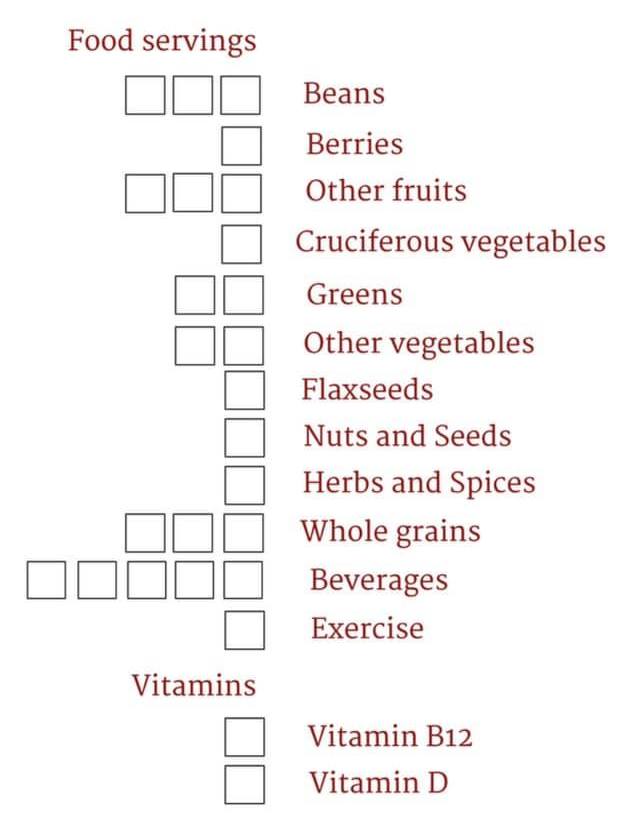- Sweet Porridge (breakfast)
- Greens, Beans & Tubers (lunch or dinner)
- Buddha Bowl / Buddha Stew (lunch or dinner)
- Salad - Sandwich (lunch or dinner)
- Green Smoothies (any time)
- Desserts (optional; if we feel like)
- Beverages (green juice & tea, any time)
The recipes above are
- For quick preparation. If we have more time, or as we become more skillful, we can learn dozens of new recipes and their variations — food can be prepared in many creative ways :-)
- For somebody who can afford all the ingredients. For low-cost recipes, we’d prepare the same recipes using the same food groups but slightly tweak the ingredients by choosing low cost options.
- For getting started immediately. Over the next several weeks and months, as we learn more about the science underlying these meal plans & recipes, and as we experiment more, we can create more and more delectable recipes :-)
- For cancer prevention. The recipes have been designed by keeping AICR & ACS guidelines in mind, along with guidelines by ACLM, Dr Greger's Daily Dozen and Dr Kristi Funk's 14-point food system.
Everybody is different! We all have to figure out what combination of foods work for us, depending upon our condition, our personal preferences and our lifestyle. What works for me may not work for you. Below I have explained how I construct my own food plates.
Consult with WFPB docs: When faced with a serious condition like cancer, it's best to take help from Whole Food Plant-Based doctor — see Plant-Based Doctors and Plant-Based Docs. Since my friend is in California, I encouraged him to consult with Dr Klaper at Plant-Based TeleHealth; Dr Klaper is a luminary in the field of lifestyle medicine with 40+ years of clinical experience.
Plant-Based Oncology Nutrition: Consider consulting with Alison Tierney
How may we build confidence that the recipes mentioned above are cancer protective?
Step 1 (5 mins): Let’s begin by studying Cancer: AICR & ACS Guidelines. Both AICR and ACS are respected organizations in USA. To get started, just skim through these guidelines to grasp the big picture. The recipes listed above are in harmony with these guidelines.
Step 2 (10 mins): What is the 10th recommendation in the AICR 10 Recommendations above? It says, “After a Cancer Diagnosis, Follow Our Recommendations If You Can.” What’s the reasoning behind this recommendation? Is cancer prevention & treatment the same? Please study My Favorite Cancer Video — please watch both videos herein to grasp what we’re trying to do. This article is part of this collection: Cancer: Genes vs Lifestyle. To get started, just browse through these articles; we may study them in detail later.
Step 3 (5 mins): To gain confidence that Whole Food Plant-Based meal plans & recipes are actually recommended by prestigious, large-sized medical organizations in USA, please browse through WFPB Endorsement by Organizations. To get started, no need to study these articles in detail; just browse through them to grasp the big picture.
Step 4 (10 mins) In case you're wondering, “if so many medical organizations acknowledge or promote the meal plans & recipes below, then why don’t medical doctors know about it? What’s going on?” :-) Funny, intriguing & sad, isn’t it? Please browse through Personal Stories of WFPB Doctors. What’s going on? Well, it’s quite simple! Nutrition is not taught in medical schools. Really?
Aren’t doctors supposed to know what we should eat? Actually, they themselves don’t really know what they or their family members should be eating, or how food can help resolve their own sicknesses. Please study the personal stories of WFPB docs in the point above to verify this.
Step 5 (5 mins) The fundamental problem is that nutrition education is virtually missing in medical schools! This point is mentioned and lamented in each and every personal story by a WFPB doctor today. We can read more about these dynamics here: Why Don't Doctors Recommend WFPB?
Step 6 (5 mins) Luckily, ACLM (American College of Lifestyle Medicine) is now in place since 2004. Just like we can get board certified to practice Interventional Cardiology or Pediatrics, we can now get board certified in Lifestyle Medicine too! This approach to medicine is lifestyle oriented in which food is #1! Food is a powerful medicine! :-) This doesn’t mean that we never use pills or procedures — we do, but lifestyle changes, especially food interventions, are the primary modality of treatment. Please browse through ACLM Dietary Guidelines — they advocate WFPB.
Step 7 (5 mins) How may physicians learn about WFPB? We have Resources for Clinicians — seminars, conferences, courses with Continuing Education Credits, handouts, PDF files with guidelines and so on — everything targeted at physicians to help them educate themselves.
Today, we do have hundreds, possibly thousands of physicians who practice Lifestyle Medicine today. But these numbers pale in comparison to hundreds of thousands of doctors who are not yet familiar with Lifestyle Medicine; most haven’t even heard of its existence. We don’t have a Lifestyle Medicine textbook yet — these are on their way, being written as we speak. By 2021-2022, ACLM is likely to publish them.
Step 8: Finally, what exactly is Whole Food Plant-Based? See next section.
To grasp the underlying philosophy for constructing WFPB food plates, it would help to browse through the links below to grasp the big picture, then jump to recipes, and then come back to these links to dig deeper into details.
- See Whole Food Plant-Based: An Overview — please read each point carefully, absorb & memorize.
- Read An Overview of Food Groups (WFPB). To get started, no need to absorb; just browse through it to get a big picture understanding of what’s going on. All these details will become clear over time as we learn more about different food groups and get personal experience with recipes.
- Browse through Cancer: Which Plants To Eat? These articles explain the science & guidelines underlying the recipes we’ll design. No need to dig into details immediately. For now, we can get started with recipes. Over time, as we pick up more knowledge, it will become clearer why these recipes are structured the way they are, and how we may tweak them.
- Next, browse through Food Groups by Dr Michael Greger — he has a 12-component system called Daily Dozen. Download Daily Dozen app (for iPhone and for Android).
- Next, browse through Food Groups by Dr Kristi Funk — she has a 14-component system which builds upon Daily Dozen but optimizes it for cancer.
- What’s the difference between Dr Greger’s 12-component system and Dr Kristi Funk’s 14-component system? Turns out that within Dr Greger’s 12 food groups, some specific foods are known to be highly cancer protective. Dr Kristi Funk has carved them out as separate components of their own to remind us that we must consume them daily.
When constructing our recipes, we'll keep Dr Greger's Daily Dozen in mind. To get started, let's just look at the broad food groups in the picture.
Now this picture is missing many details. For example, what is 1 serving of beans? What is 1 serving of nuts & seeds? Which berries are great? And so on. To get started, we don’t really need all these details. Just a broad overview of various food groups, and the rough ratios in which to eat them is good enough. Over time, we can pick up details by playing around with the app and browsing through Food Groups by Dr Michael Greger.
Even after picking up all these details, I keep these two things in mind:
- If we follow the Daily Dozen to the dot, then we get roughly 1400-1500 calories. So those eating more (for example, athletes), may have to scale the Daily Dozen to eat more.
- I see these food servings as approximate guidelines. In other words, it's okay to eat more beans, more ‘berries’, more ‘other veggies’, etc. in a day. Very few people follow the Daily Dozen rigidly in terms of serving sizes. At the same time, we must not eliminate any food group altogether, or reduce it to tiny quantities — each and every food group is well thought through!
The Daily Dozen is actually a beautiful work of nutrition engineering which can be appreciated only after we study in depth as to why each of these components is there! Why don’t we have more components? Why not fewer? Why these approximate ratios? And so on. There is good scientific reasoning behind each food group.
In sections below, we’ll devise a few simple but flavorful recipes to cover various food groups shown in the pic.
Dr Greger’s Daily Dozen: free, easy-to-use, ad-free app: for iPhone and for Android.
Cronometer: Website and app (for Android and for iPhone). Best app for nutrition information (both macro- and micro-nutrients) for various raw & processed foods. I find the web interface easier to use.

 Instagram
Instagram YouTube
YouTube